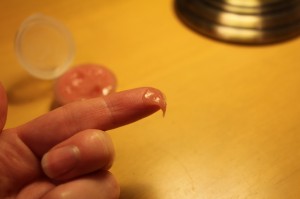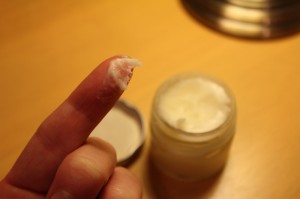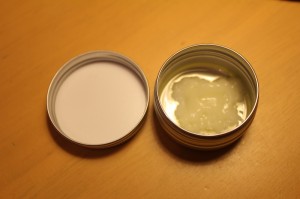I’ve been absent for a while, I know – mainly due to travelling, illness, and then simply having gotten out of the habit. I actually think about blogging all the time, and am often jotting notes for posts I’d like to write, but often feel too tired by the evening to sit down and write something extended. So tonight I thought I’d just share a few of the things I’ve been doing, while I’m writing other, more discursive, things for posting later.
So, I mentioned a while ago that I was trying a few homemade beauty products. I should have known this would be a slippery slope! At first, I kept feeling annoyed when I’d find recipes that called for five different types of oil. ‘Why don’t these people get a life?’ I thought. ‘Who wants to buy little bottles of five different botanical oils?’ But then I started funnelling my spending money towards my new hobby. A few months later I myself had a whole drawer full of little brown bottles and found myself blithely concocting in my kitchen and smearing my mixtures all over my hands and face.
One of my first projects was lip balm, and this is truly easy to make from a mixture of beeswax and oils. The hardness can be adjusted by varying the amount of beeswax, and the viscosity will vary according to the thickness of the oils used. Also, compared to stuff like Burt’s Bees, it’s really inexpensive while having comparable ingredients.
Slightly more surprising to me was this recent attempt at lip gloss. For some reason I’ve had a nostalgic hankering for lip gloss lately – maybe because it reminds me of the excitement of being young and putting it on for a special occasion, back when it was probably the only makeup I’d wear. But I anticipated that the signature sticky liquidity of lip gloss would be hard to replicate at home – it’s quite different from a balm. But it turned out to be easier than I expected. It’s essentially a very soft lip balm (wax+oil) emulsified with honey and glycerine, both of which are sticky and syrupy. The colour comes from some shavings of lipstick, but it goes on nearly clear.
I was actually very surprised by how much the texture replicated store-bought lip glosses. It even has a little bit of sweetness from the honey, though no other flavour or scent, other than a slightly strange flavour of oils. But all the ingredients (with perhaps the exception of the lipstick) are basically edible (even glycerine is used in food).
This hand cream is a failure-turned-success. I made it initially for my face, but decided that homemade creams aren’t suited to my skin. Although I haven’t had any breakouts from using oil on my face, creating a cream requires oil and water to be emulsified together with the aid of beeswax to keep the water in suspension (just like making mayonnaise, where the egg does the work of the beeswax), and I’m pretty sure that no matter how much the other ingredients in the cream absorb, the wax just sits on the surface blocking pores. So I didn’t like this cream on my face, but I love it on my hands. In fact, because of the wax, it does leave a slight film on my skin afterwards, but that’s ideal for applying just before leaving the house when the weather’s cold, because it forms a barrier. I usually get very itchy eczema in the winter, so I’m hoping this cream might help with that. I keep it in the fridge because, although my aloe vera itself contains preservatives, I wasn’t sure if they would keep the whole cream from going off. But it has been fine thus far in the fridge, and it’s handy in the kitchen after I’ve washed my hands.
Here we have some gloup that is a work in progress, which is why I only made a tiny bit. It’s weirdo moisturiser. Facial skincare is the hardest thing to work out when using homemade products, or at least in the case of ‘problem skin’. Some bloggers promise that slathering yourself with plain coconut oil is the answer, but I’m pretty sure it isn’t that simple. In essence, the problem is that your skin needs moisture both in the form of oil and water, but of course oil and water don’t mix so can’t be simply combined. As I said above, combining them in the form of a cream requires wax, which leaves a residue. Commercial moisturisers are either oil-free or use emulsifiers that are more sophisticated and don’t leave the residue. But since I like both aloe vera and jojoba oil for my face, I decided to try whipping them together with a little glycerine (which I also love), and, as I suspected, for the most part they stayed in suspension. It’s either because the aloe is a thick gel which has enough structure of its own, or because the jojoba oil is technically a ‘liquid wax’ rather than an oil proper. There’s a little oily residue left, but for the most part the opaque gloup has stayed stable at room temperature. I haven’t used it for enough days in a row to know whether it works well on my skin, but I would swear from past experience that jojoba oil actually makes my skin less oily overall than a normal light moisturiser. That’s one reason I’m very keen to see if I can make it work.
To summarise, although I’ve had many failures in my DIY products, this has been a lot of fun. For the most part, even my failed experiments can be repurposed (like the cream above), so I haven’t actually wasted very much. A few of the things I really like about this hobby are:
- It’s a hobby that produces something useful…so I do feel that when I spend money on my ingredients I’m getting double value in both entertainment and a usable product.
- I’ve enjoyed de-mystifying some of the things I use daily, like lip balm and hand lotions. It’s enjoyable to understand how things are made (I used to love those TV programs that tour a factory and show how something is produced), and why they work.
- Although I admit I’ve shelled out quite a bit of money acquiring my ingredients, I’ve been making these things for about six months now and most of my oils are still over half full. They don’t last forever, but most have a shelf life of at least a year or more, so relatively speaking I feel like it’s a cost-effective (if not cheap) endeavour.
- And while I don’t want to jump on fear-mongering bandwagons that sometimes go around about ‘the deadly toxins in everyday products’, I think it’s pretty indisputable that natural ingredients are better in the long run. So long as they work and aren’t exorbitantly expensive, I’m pleased to use my homemade versions where I can.
I’m of two minds, now, when it comes to skincare products. On the one hand, I’ve been quite pleased to discover that in many regards it’s not rocket science. By and large, I feel that a whole realm of my daily life has been de-mystified (as I said). Not only am I better able to read ingredient labels, but in general I understand what ingredients are doing for the texture or effectiveness of something in a little bottle or tube.
This being the case, I do, however, have a new degree of respect for commercial products. Some people who advocate more ‘natural’ beauty products (though not all) can seem to take a very oversimplified approach. The use of preservatives comes under a lot of fire on some blogs and forums. While I understand that people have health concerns sometimes associated with ingredients like preservatives, I do now realise how necessary those things are. In other words, they are not just ‘nasty stuff the big companies throw in’. They’re to enable you to keep a bottle of lotion in your bathroom without it growing mould. And in many cases, just because something is natural doesn’t mean it isn’t problematic. Coconut oil doesn’t work well at all on my face – whereas my standard, inexpensive Simple moisturiser does. Although, if that jojoba oil gloup comes through for me…! We’ll see.




